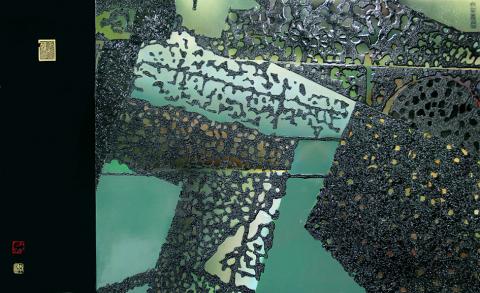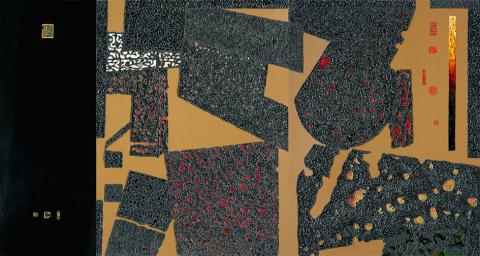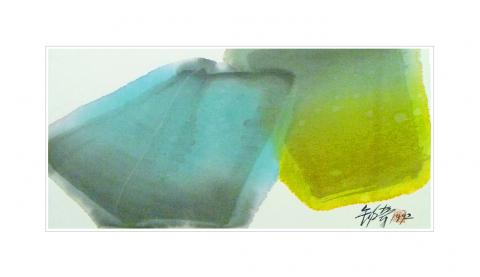The Chinese Nationalist Party’s (KMT) escape from China in 1949 following the civil war and its subsequent defense alliance with the US had the unintended benefit of introducing Taiwanese artists to the theories and practices of emerging American and European art. Like many young artists of his generation, Lee Hsi-chi (李錫奇) eagerly absorbed these new styles, creating abstract expressionist paintings using lacquer. Yet as his use of materials suggests, Lee didn’t surrender to Western art forms. Rather he combined them with Eastern aesthetics — a fusion that is apparent in Oriental: The Elegance of Han Dynasty (漢采本位), a retrospective exhibition currently on view at MOT/Arts. The title stems from Lee’s close study of Han Dynasty architecture, particularly its forms, symbols and materials. In these paintings, Lee carefully manipulates lines and spatial planes to create depth and distance. The exhibition not only illustrates the maturity of an important Taiwanese artist, but also gives the viewer a sense of the development of modern painting in Taiwan.
■ MOT/Arts, 3F, 22, Fuxing S Rd Sec 1, Taipei City (台北市復興南路一段22號3樓), tel: (02) 2751-8088. Open daily from 11:30am to 8pm
■ Until March 3
.jpg)
Photo courtesy of MOT/Arts

Photo courtesy of MOT/Arts
.jpg)
Photo courtesy of MOT/Arts


Photo courtesy of MOT/Arts

Photo courtesy of MOT/Arts

This is the year that the demographic crisis will begin to impact people’s lives. This will create pressures on treatment and hiring of foreigners. Regardless of whatever technological breakthroughs happen, the real value will come from digesting and productively applying existing technologies in new and creative ways. INTRODUCING BASIC SERVICES BREAKDOWNS At some point soon, we will begin to witness a breakdown in basic services. Initially, it will be limited and sporadic, but the frequency and newsworthiness of the incidents will only continue to accelerate dramatically in the coming years. Here in central Taiwan, many basic services are severely understaffed, and

Jan. 5 to Jan. 11 Of the more than 3,000km of sugar railway that once criss-crossed central and southern Taiwan, just 16.1km remain in operation today. By the time Dafydd Fell began photographing the network in earnest in 1994, it was already well past its heyday. The system had been significantly cut back, leaving behind abandoned stations, rusting rolling stock and crumbling facilities. This reduction continued during the five years of his documentation, adding urgency to his task. As passenger services had already ceased by then, Fell had to wait for the sugarcane harvest season each year, which typically ran from

It is a soulful folk song, filled with feeling and history: A love-stricken young man tells God about his hopes and dreams of happiness. Generations of Uighurs, the Turkic ethnic minority in China’s Xinjiang region, have played it at parties and weddings. But today, if they download it, play it or share it online, they risk ending up in prison. Besh pede, a popular Uighur folk ballad, is among dozens of Uighur-language songs that have been deemed “problematic” by Xinjiang authorities, according to a recording of a meeting held by police and other local officials in the historic city of Kashgar in

It’s a good thing that 2025 is over. Yes, I fully expect we will look back on the year with nostalgia, once we have experienced this year and 2027. Traditionally at New Years much discourse is devoted to discussing what happened the previous year. Let’s have a look at what didn’t happen. Many bad things did not happen. The People’s Republic of China (PRC) did not attack Taiwan. We didn’t have a massive, destructive earthquake or drought. We didn’t have a major human pandemic. No widespread unemployment or other destructive social events. Nothing serious was done about Taiwan’s swelling birth rate catastrophe.